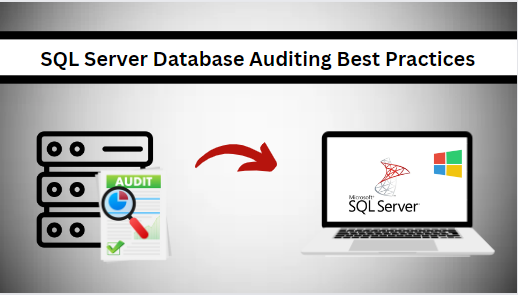Microsoft SQL Server Audit Best Practices

Overview: Microsoft SQL Server log files are the most crucial files that record all transactions and modifications that are made to the database. It is essential to check the log file in SQL Server for many reasons. In this blog, we discuss a complete guide on SQL Server audit best practices and provide the best approach to do this.
In today’s digital era, data is like gold. Many businesses and IT companies store a vast amount of sensitive information in their database and protecting these crucial data is paramount for them. For that, SQL Server audit comes and plays an important role. In simple terms, the user should use the SQL Server auditing best practice technique to record action-specific actions made in the database. It helps users to monitor activity, identify potential security threats, and ensure compliance with regulations. In this technical guide, we will discuss why SQL Server Audits are important and what techniques you should try to keep track of all the changes.
Now. Let’s discuss why users require best practices for database auditing in SQL Server.
SQL Server Database Auditing Best Practices
Users can track all the events made in SQL Server data through this powerful feature of SQL Server audit. It is a robust application for maintaining and managing the security, compliance, and integrity of the database.
Now, Let’s Explore Why Microsoft SQL Server Audit Best Practices Important:
Here are some of the key points that users need to remember to safeguard their digital data. Let’s discuss database auditing best practice SQL Server –
- Establish Clear Audit Goals(Start with a Plan): Before you start the SQL auditing best practices process, it is important to set a clear audit goal. This will help you to identify the types of actions including – logins, logouts, data modifications, and schema changes.
- Activate Server-Level Auditing ( Choose What to Audit): Users have the option to audit all data or choose not to by following recommended practices for auditing SQL Server data. This enables users to record all the changes that were made in SQL Server data and check all activity across all databases on the system..
- Create Audit Specifications: SQL Server audit best practices is a built-in function to track and record activity on your SQL Server instance. It enables users to view and check the requirements for monitoring (keeping an eye on) and recording specific SQL Server processes.
- Define Audit Targets: Auditing rules targets allow users to determine the scope of auditing and the actions that will be audited in SQL Server. Implementing auditing processes in the SQL Server database guarantees that all relevant activities are captured and documented.
- Enable Your Audits: Enabling the SQL Server audits allows users to notice any odd behaviour or unlawful access. Reviewing audit logs regularly helps them to identify potential security vulnerabilities and execute risk mitigation steps.
By adhering to these SQL Server Auditing Best Practices, SQL Server users may increase the security and integrity of their database. It is crucial to protect their organisation’s information from security threats.
If your SQL Server database file (MDF/LDF) is corrupted or damaged, consider using the SQL Recovery Tool . This tool helps in recovering and previewing the SQL Server database objects like – tables, triggers, functions, stored procedures, views, and more.
Types Of Auditing in SQL Server
There are two main auditing types in SQL Server audit best practices. Let’s have a look on them:
- Server-level auditing: This type of audit tracks all the changes that occur on the whole SQL Server instance. Moreover, it serves as a primarily tool used for SQL Server extended events and SQL Server audits to offer detailed auditing capabilities. These events can include server startup and shutdown, login and logout attempts, and changes to server configuration..
- Database-level auditing: This type of audit tracks events that occur within a specific SQL Server database. It allow users to track actions such as – INSERT,UPDATE, DELETE on table, schema , permission changes,
Users can customize both SQL Server auditing types (server-level and database-level audits) to meet their specific needs. Users can only do this by using the audit action group and audit actions.
Also Read: How to Read SQL Server Logs File? Quickly
Audit SQL Server Database with Expert Suggested Tool
SQL Log Explorer Tool is a top-notch application used to read, view, and analyze all the changes made in SQL Server database. The tool analyzes all the operations of the Transaction log file (LDF) without the MS SQL Server program. Additionally, users can easily implement “ SQL Server audit best practice” without any hassle.
With this tool, you can analyze the SQL transaction log (.ldf) file to find important changes in the record. The utility provides three scan mode options – Export as SQL Server database, Export as SQL Server compatible SQL scripts, and Export as CSV file.
Step-by-step Guide on SQL Server Database Auditing Best Practices-
Step 1: First, download and run the tool on your Windows machine and click “open” to add the LDF file. 
Step 2: After that, select “online” or “offline mode” and enter the SQL Server credentials. Hit the OK button. 
Step 3: Preview all corresponding database files through the left panel. 
Step 4: Next, select the desired filter for data export or further examination. 
Step 5: Finally, click on the export button for SQL auditing best practices. 
Concluding Words
Microsoft SQL Server audit best practices is a crucial process. This guide discussed Database auditing best practice SQL Server. Users need to understand why it matters a lot to protect sensitive information. However, if you want to protect and safeguard your digital data then you can use the Expert suggested solution. It is a trusted and reliable solution to accomplish the task.
